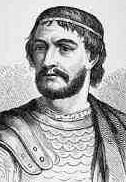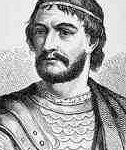
Date of Birth
670
Place of Birth
Herstal, Arrondissement de Liège, Liège, Belgium
Towns / Cities Moved Into
Herstal, Arrondissement de Liège, Liège, Belgium |
Liège, Arrondissement de Liège, Liège, Belgium |
Marolles-sur-Seine, Seine-et-Marne, France
Known Occupation
Duke of Burgundy and Provence
Count of Autun
Seigneur de Perracy and de Bougy
Religion
-
Spouse
Death Information
Year of death
751
Place of death
Liège, Arrondissement de Liège, Liège, Belgium
Cause of death
-
Obituary

Parents

Pepin "the Younger" Deheristal

Duchess Aupais Chalpaide Von Bavaria
Marital Status


Married Emma Von Austrasia
Siblings


Children




Narrative / Story
In the annals of medieval European history, Count Childebrand I of Austrasia De Perracy emerges as a figure of considerable significance. Born in 670 in Herstal, Belgium, his life was a tapestry of feudal power, familial alliances, and the shifting dynamics of early medieval politics. As the Duke of Burgundy and Provence, Count of Autun, and Seigneur de Perracy and de Bougy, Childebrand navigated the complexities of aristocratic life with the acumen befitting a man of his stature.
Childebrand’s early years in Herstal were likely marked by the education and training typical for a noble of his time. His subsequent moves to Liège and Marolles-sur-Seine were not mere changes of scenery but strategic relocations, reflecting the demands and duties of his noble status. These moves were emblematic of the mobility and the intricate network of feudal obligations that defined the era.
His marriage to Emma of Austrasia was a union that not only bonded two individuals but also united powerful families. Their children, Nibelung I de Perracy d’Autun, Teiric I d’Autun, William of Gellone, and Raoul I (Robertian), were not merely his heirs but pivotal figures in the perpetuation of his lineage and its influence across the regions he governed.
Childebrand’s professional life was consumed by the responsibilities inherent in his titles. He was deeply involved in the governance of his territories, which required a delicate balance of diplomacy, military strategy, and the management of feudal relationships. His participation alongside Charles Martel in the campaigns against the Saracens in Avignon and Narbonnaise in 737 underscored his military prowess and his role in the broader political affairs of the Frankish kingdoms.
As a patron of the continuator of the Chronicle of Fredegar, Childebrand demonstrated a keen understanding of the power of knowledge and narrative. His support for this historical work was not just about preserving history but also about shaping the narrative of his time, highlighting his awareness of the cultural and intellectual currents of his era.
The socio-economic landscape of Childebrand’s time was characterized by rigid feudal hierarchies. As a member of the nobility, he was insulated from many of the hardships faced by the lower classes, such as serfdom and limited social mobility. However, his life was not without its challenges. The constant power struggles and military conflicts of the era were sources of perpetual risk and uncertainty.
Childebrand’s death in 751 in Liège marked the end of an influential life. The details of his burial, though not explicitly documented, suggest a resting place befitting his status, likely in a family crypt or a church he patronized. His passing signified not just the loss of a powerful individual but also the closing of a chapter in the history of his family and the regions he governed.
Reflecting on Childebrand’s life offers a window into the life of a medieval noble. His existence was far from the simplicity often associated with the era; it was instead filled with the complexities of governance, warfare, and the management of vast estates and political relationships. His life was a tapestry of duty, power, and the perpetual navigation of the intricate feudal system.
The legacy of Count Childebrand I of Austrasia De Perracy is woven into the fabric of early medieval European history. His story is not merely one of personal achievements but also a reflection of the broader socio-political and economic currents of his time. In understanding his life, one gains insight into the early stages of the Carolingian dynasty’s rise and the intricate tapestry of feudal Europe.
In sum, Childebrand’s life, marked by political power, military campaigns, cultural patronage, and familial dynamics, offers a rich narrative that encapsulates the essence of early medieval European nobility. His story, set against the backdrop of a changing Europe, is a testament to the complexities and intrigues of a time that laid the foundations for the future of the continent.